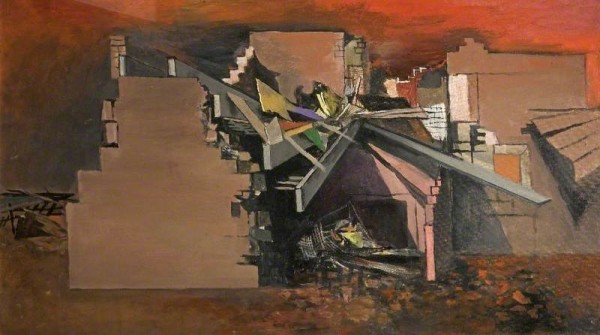
Sutherland, Graham Vivian; Devastation, House in Wales; Cheltenham Art Gallery & Museum (The Wilson).
A haunting image!
I was recently asked to talk, briefly, about a favourite work in the Art Gallery & Museum at Cheltenham (The Wilson). This posed a problem – for I have always been uncomfortable about having a ‘favourite’ painting or ‘liking’ a painting – what does one mean by ‘like’?
So with these qualms in mind I have opted for Graham Sutherland’s ‘Devastation, House in Wales’. When I first came across this painting, in 1973 on first taking up the post at the Art Gallery and Museum, my initial reaction was a combination of the joy of having a work by a major modern British artist and an emotional horror at the scene depicted, or interpreted. That horror was because it brought back to me my personal experience of the devastation and suffering of WW2 bombing. I remember vividly a particular experience – having travelled with my family, I was about six years old, from Bolton to Sheffield to see my grandparents. Bolton had not suffered particularly badly from bombing as the German planes flying over were heading for Manchester and Liverpool, occasionally they jettisoned bombs on their return but causing relatively little damage or carnage. Travelling, by a very crowded train, from Lancashire to Yorkshire was, for safety reasons, through the longest route through the Pennines, the Woodhead Tunnel. On this occasion when we stepped off the train in Sheffield I was immediately struck by an eerie silence and a strong acrid smell from plumes of smoke amidst devastated buildings which I had known as shops, offices, and public buildings as well as houses. Overnight the centre of Sheffield and the massive steel works surrounding the city had been severely bombed.
This painting hit a nerve. As a Government commissioned War Artist, chosen by Sir Kenneth Clarke, Sutherland went around the country recording, quite deliberately, scenes of bombing damage outside London – in this case to the industrial areas of south and mid Wales. As an adult, studying art history and then on to Curatorship, I had seen many types of depictions of war damage – most of them realistic, almost topographical, works. This work is of a different order completely. In this work, small as it is, the artist has used his ‘advanced’ abstract methods to really reveal, almost physically, the feeling of a bomb dropped INTO a house – forcibly destroying the fabric and ‘soul’ of an innocent building and its occupants. The artist does this by his use of line, form, and colour in a powerful and unnerving way. One can feel the impact of the bomb as forcibly and suddenly it thrust itself into the building, destroying everything around. The strong and forceful lines of the composition, the sharply angular forms, and the vivid clashing colours with more sombre tones. Nothing moves, nothing living, Silence – with the possible occasional sudden fall of fractured masonry.
This is a work which is not to be passed by casually – but visually studied and explored.
